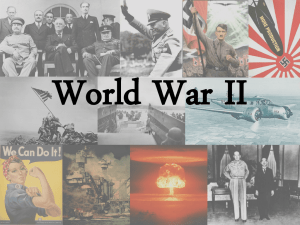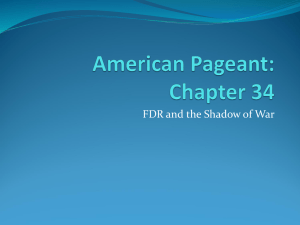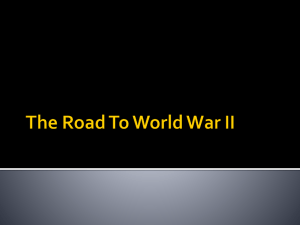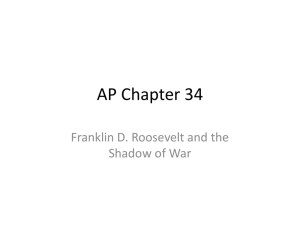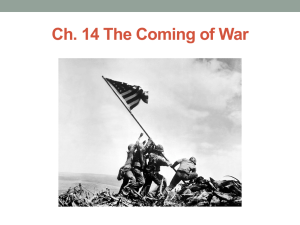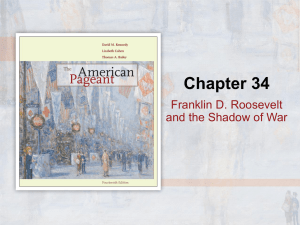Chapter 34 Lecture: FDR and Shadow of War
advertisement
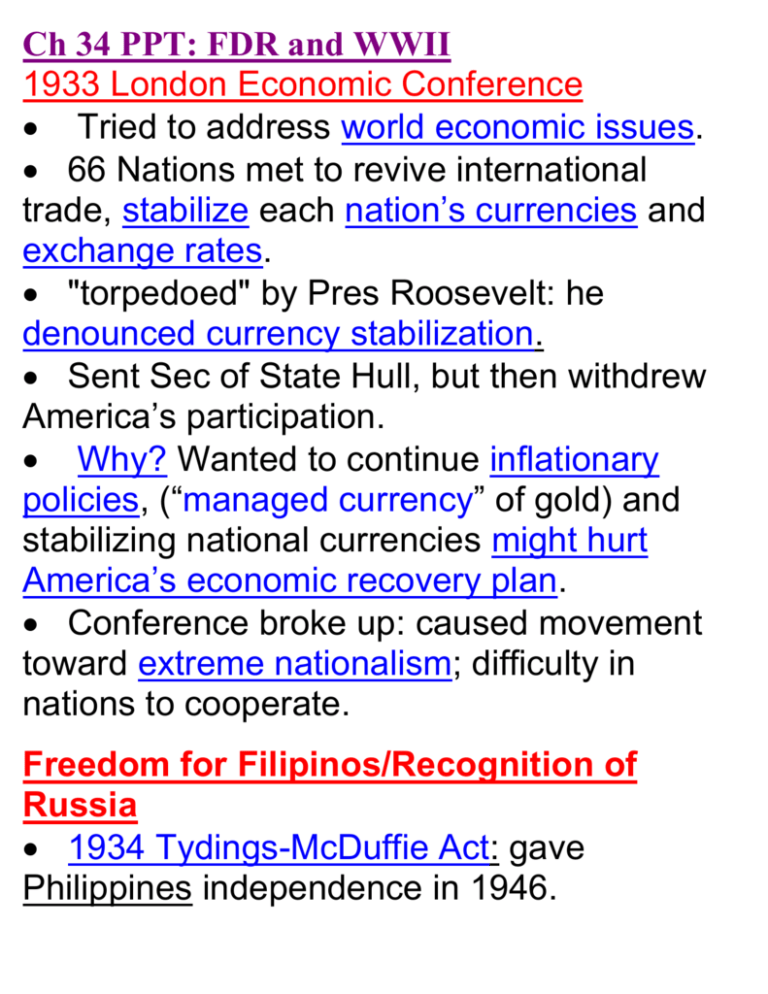
Ch 34 PPT: FDR and WWII 1933 London Economic Conference Tried to address world economic issues. 66 Nations met to revive international trade, stabilize each nation’s currencies and exchange rates. "torpedoed" by Pres Roosevelt: he denounced currency stabilization. Sent Sec of State Hull, but then withdrew America’s participation. Why? Wanted to continue inflationary policies, (“managed currency” of gold) and stabilizing national currencies might hurt America’s economic recovery plan. Conference broke up: caused movement toward extreme nationalism; difficulty in nations to cooperate. Freedom for Filipinos/Recognition of Russia 1934 Tydings-McDuffie Act: gave Philippines independence in 1946. 1933: U.S. formally recognized USSR - to try to open up trade – anti-communists and Roman Catholics disagreed. Good Neighbor Policy Goal: have good relations with Latin Am. by renouncing military intervention. (Use other methods). Give up Corollary of the Monroe Doctrine. In 7th Pan-American Conference - U.S. endorsed nonintervention. Why? Get Latin American countries on U.S. side; help defend Western hemisphere against dictators. U.S. Marines leave Haiti,1934. Secretary Hull’s Reciprocal Trade Agreements Secretary Hull wanted low-tariffs (reminder: wanted high tariffs) Why? He believed lowering tariffs would cause nations to lower their tariffs and so help trade between nations. 1934 Reciprocal Trade Agreements Act: Negotiation of tariff agreements, with Pres. power, between the U.S. and separate nations, particularly Latin American countries. Result: U.S. foreign trade increased and later resulted in the U.S. led free-trade international economic system. Tmwk 34 1. pg 804 What is Benito Mussolini's viewpoint in his quote? (Include topic and his opinion) 2. Pg 805 Cartoon: What is the cartoon depicting and is it for or against something? (topic, time period, key ppl, location and add OI) 3. Pg 807 What is the cartoon depicting? (topic, time period, key ppl, location and add OI) Dictators and Totalitarianism Threat of dictators and totalitarianism arises – Communist USSR led by Joseph Stalin, Benito Mussolini in Italy, Adolf Hitler in Germany Germany especially was resentful about taking blame for WWI, disarmament, war payments ($33 billion), loss of land. Congress Legislates Neutrality Neutrality Acts 1935, 1936, 1937: When Pres declared existence of a foreign war, restriction of the seas would go into effect - to keep U.S. out of WWII: – No American could sail on a belligerent ship during war; (declared that American citizens traveling on warring ships traveled at their own risk) – No American could sell or transport munitions to belligerent nations, nor make loans. – These acts abandoned the policy of freedom of the seas. America Dooms Loyalist Spain Spanish Civil War of 1936-1939: Fascist General Francisco Franco sought to overthrow Loyalist govt in Spain. General Franco backed by Hitler and Mussolini. To continue neutrality, U.S. forbid arms trade with Spain (made arms embargo against both Loyalists and rebels.) General Franco becomes dictator of Spain TMWK: 4. Pg 810 Quote: What is Hitler's viewpoint? (topic, time period, key people, location and Add OI) Appeasing Japan and Germany 1937 Japan invaded China FDR gives “Quarantine speech” due to aggression of Japan and Italy, calling for an international "quarantine of the aggressor nations" using economic embargoes. Outcry led FDR to withdraw this idea. The Combatants Big Three leaders: Churchill, Stalin, FDR Allies: Britain, France, USSR, China, US Axis Powers: Germany, Japan, Italy Hitler’s aggression: - 1936: Marches into Rhineland area - 1938: occupied Austria – his birthplace - Sept. 1938: Munich Conference: allowed Hitler to take Sudetenland (part of Czechoslovakia) – European democracies appease Hitler. - 1939: seizes rest of Czechoslovakia What agreement was made between and so that wouldn't have to fight a two-front war? A: Hitler’s Agression and U.S. Neutrality Aug 1939 - USSR signs Non-aggression Pact with Germany – Hitler didn’t want to fight two-front war. Gave Hitler a way to attack Poland on Sept. 1, 1939: WWII Begins! -without fear of USSR U.S. declares neutrality- 1939 Neutrality Act: European democracies may buy American war supplies, but only by “cash and carry”: Pres allows sale of war materials to European democracies, but must transport them on their own ships and pay immediately in cash. This helps U.S. to avoid loans, war debts, ` But, it hurts China, who was blockaded by Imperial Japanese Navy. Selling war supplies to European democracies helped bring U.S. out of Great Depression. TMWK 5. Pg 812 What was significant after France fell under Germany control in June 1940? 6. Pg 813 What is the cartoon depicting? Is it for or against something? (topic, location, add OI.) Fall of France June 1940: France’s fall to Germany ended U.S. neutrality. FDR called for building of airfleets and twoocean navy – Congress gave $37 billion. Congress passed conscription law for the 1st peacetime draft. With Poland, Netherlands, Denmark and France all under Germany control: 1940 Havana Conference called: U.S. along with 20 nations agreed to uphold Monroe Doctrine to keep Hitler out of Western Hemisphere. 1940 Bolstering Britain: the Destroyer Deal Hitler launched air attacks against Britain in Summer 1940 - Battle of Britain. Two Camps: some supported aid to Britain, formed propaganda groups – Committee to Defend America by Aiding the Allies: Give Britain “all aid short of war.” Isolationists formed the America First Committee, led by Charles Lindbergh – determined to avoid American bloodshed. Sept 1940: FDR struck deal with Britain giving them 50 old destroyers. In return, Britain promised to give U.S. 8 naval bases in the western hemisphere. (this violated neutrality) TMWK 7. Pg 815 Give 3 details about the presidential election of 1940. FDR Runs for 3rd Term Republican candidate Thomas Willkie – lawyer who didn't have political experience: ridiculed FDR for being a dictator Democrat candidate FDR – running for unprecedented 3rd term. Why? Felt his leadership and experience needed during the war crisis. Both promised to stay out of war and strengthen nation’s defenses. TMWK 8. Pg 816 Map: Give a detailed description of the Lend-Lease Act. 9. Pg 816 Top picture: Who was particularly against the Lend-Lease Act and why? March 1941: Congress Passes Lend-Lease Law = Economic Declaration of War Lend-Lease Program: U.S. to supply Britain, Soviet Union, China, France and other Allied nations with materials ($50.1 billion in supplies) from 1941-1945. Britain in return gave U.S. military bases in Newfoundland, Bermuda, and British West Indies. “An act to further promote the defense of the U.S.” “send guns, not sons.” “Billions not bodies” Allies were to return used weapons when war ended. “Who wants a chewed up tank?” Caused U.S. factories to produce for all-out war production; helped get U.S. out of GD. Hitler saw this as undeclared war – begins to torpedo American ships. TMWK 10. Pg 818 What is the cartoon depicting? Is it for or against something? (topic, period in history, location, add OI.) Hitler’s Attack on USSR Spawns the Atlantic Charter U.S. started Lend-Lease: March 1941. $11 billion to USSR June 1941: Germany attacks USSR wanted to take their oil and other resources. Aug 1941 Atlantic Conference - Winston Churchill and FDR met on a warship: Made an Eight-Point Atlantic Charter outlining war’s end: 1. No territorial changes 2. People have right to choose own govt (self-determination), 3.Regain govts abolished by dictators, 4. Disarmament, 5. permanent organization for security. U.S. Destroyers and Hitler’s U-Boats Clash Lend-Lease shipments now attacked by German U-Boats – freighters would need escorts by warships. U.S. navy to escort shipments to Iceland, then Britain would lead them rest of the way. U.S. Destroyer Greer attacked by U-Boat – FDR proclaimed “shoot-on-sight” policy. U.S. Destroyer Rueben James: torpedoed and destroyed – over 100 casualties. Congress now declares that merchant ships could legally arm and enter combat zones with arms for Britain. Surprise Assault on Pearl Harbor Japan needed steel, scrap iron, and oil from U.S. Late 1940: U.S. imposed embargo on supplies to Japan Mid 1941: froze Japanese assets and stopped all shipments of gas. State Dept. required Japan to leave China then U.S. would start trading again with Japan, but Japan didn't leave China. Dec 7, 1941: Japan attacked Pearl Harbor on “Black Sunday” “A day which will live in infamy.” 3,000 casualties. U.S. was expecting an attack, but thought it would be in Pacific area – Malaysia or Philippines. Aircraft destroyed, battleship fleet (8) sunk or immobilized. Luckily, 3 aircraft carriers were outside the harbor. U.S. Declares War on Japan Dec. 8, 1941! (on Germany Dec 11) Japan Japan able to expand control from border of India in the West and New Guinea in the South within 6 months. 1933: Japan withdrew from League of Nations; criticized for actions against China. July 1937: 2nd Sino-Japanese War Became full scale war by Kwantung army acted independently from a moderate govt. Japanese succeeded in occupying almost whole coast of China, committing severe war atrocities on Chinese population, especially in capital, Nanking. Chinese govt never surrendered completely. 1940: Japan occupied French Indochina (Vietnam) upon agreement with French Vichy govt, and joined Axis powers of Germany and Italy. These actions intensified Japan's conflict with the U.S. and Great Britain which reacted with an oil boycott. Oil shortage made Japan decide to capture Dutch East Indies for oil (Indonesia) and to start war with US and Great Britain. The turning point in the Pacific War was the battle of Midway in June 1942. From then on, the Allied forces slowly won back the territories occupied by Japan. In 1944, intensive air raids started over Japan. In spring 1945, US forces invaded Okinawa in one of the war's bloodiest battles. On July 27, 1945, the Allied powers requested Japan in the Potsdam Declaration to surrender unconditionally, or destruction would continue. However, the military did not consider surrendering under such terms, partially even after US military forces dropped two atomic bombs on Hiroshima and Nagasaki on August 6 and 9, and the Soviet Union entered the war against Japan on August 8. On August 14, however, Emperor Showa finally decided to surrender unconditionally.

